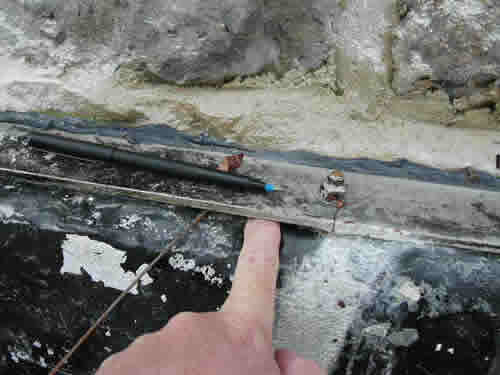 |
Ideally, there should be no penetrations through a geomembrane lining system. However, it is not always possible to avoid them. The next best approach is to minimize the number of these penetrations. It is essential that great attention be paid to these details, as the tendency is to over-specify geomembranes and their manufacturing quality control (MQC) and site construction quality assurance (CQA). Due to a lack of experience, specifiers and engineers tend to overlook the importance of penetrations; too often they simply rely on the installers to do whatever they believe is best.
Unfortunately, there is very little published info on this topic.
geosynthetica.net interviewed Du Toit Viljoen of South Africa-based Engineered Linings. They’ve dealt with this situation with many clients over the past few decades.
**
Instructive Comments
"There are several types of penetrations through liners," Viljoen says. "Pipes, manholes, columns, walls, sumps, etc. We have found the most reliable sealing detail to be the clamping of a geomembrane between two pipe flanges. We use a single or double gasket to provide the necessary sealing effect. But, when it comes to sealing onto concrete surfaces, it is much more difficult to get a good seal.
"Back in the mid-1980s when I worked in the US we used to use an 8-mm-thick closed-cell Neoprene gasket. Its reference was R-451-N, made/sold by Rubatex. The density was 22–35 p.c.f. and it had compression deflection of 17–24 p.s.i.
"When I returned to South Africa in 1989, we could not get the same density here. We first tried a Neoprene 25, which had a density of only 160 kg/m^3, but this permanently deformed too much to our liking – sometimes the 8 mm initial thickness collapsed down to approximately 1 mm only! We researched the market and finally found a 6-mm-thick natural gum rubber to deliver good results.
"Depending on the application, one naturally always needs to keep the chemical resistance of all products in mind."
Gasket Notes
Critically important is that the holes through the gasket should be pre-punched (and not drilled)—typically about 3–4 mm smaller than the bolt diameter to ensure a nice, tight fit around the bolt shaft. Also, it should fit on the smooth shaft of the bolt—not on the threaded section. If this is not possible, a bit of silicone around the bolt can help to prevent the water from running through the threaded section. A bit of silicone on the concrete surface can help as well, but one must be careful not to use too much: it just might lubricate the surface of the gasket, and while one torques the nuts, the gasket may slide or bulge to one side and leave a gap between the gasket and the bolt shaft.
The ends of the strips of gaskets should be chamfered at ca. 45º. Then, glue them together. For example, where a square frame is made up around a penetration, the four corners should be glued, and the joints in the steel batten should always be off-set from the joints in the gasket.
Specifications on 6 mm natural gum rubber in South Africa:
• Its compound reference is NR40
• Hardness = 40 IRDH (± 5 units)
• SG is 1.12
• Its elongation at break is 660%
Dimensions of flat steel batten strips and bolt spacing:
• This depends on the hydraulic head: “For less than one meter head,” Viljoen says, “we use 40 x 4.5 mm (for stainless steel) and 40 x 5 if it is galvanized; it is fastened with 8 mm nail plugs or bolts at max 160 mm c/c.
• “If >1 m head, we use 40 x 6 mm battens with 10 mm bolts at max 160 mm c/c. Bolts should be torqued to 35 Nm, and re-torqued the next day after the gasket has been allowed to settle. Stainless steel nuts may tend to weld onto the bolt shafts, so ensure that you can tighten them the next day.”
Making It All Work
Viljoen finds that one rubber strip between the concrete surface and the geomembrane is generally adequate, but his company has had many projects on which a gasket had been specified on both sides of the geomembrane.
"It is essential that the concrete surface has an even, smooth steel trowel finish," he says.
He does not like to use angle iron, as the concrete surfaces are not always straight, and it is impossible to bend an angled section to follow the contours of the concrete surface.
A loose skirt of geomembrane, ideally with no welds entering the area in contact with the gaskets, should be used to ensure proper access to the working face, and the welding of the skirt to the main lining – only to be done after the gasketting had been completed and all bolts fastened – ensures that the main lining is as stress free as possible.
He feels quite strongly about avoiding boot details at all costs: "Many engineers tend to specify a boot detail around a pipe," he says. "At a 90º angle it is already difficult. On a slope, it is impossible to obtain a 100% liquid tight joint; yet, engineers expect installers to weld underneath pipes, at an ever-changing angle, to weld these boots to the pipe walls."
He suggests using a pre-manufactured high-density polyethylene (HDPE) flange, pre-welded onto the HDPE pipe at the appropriate slope angle. Cast it into the concrete slab around the pipe, then fix the main lining onto the concrete slab and cover the last bit of exposed concrete (in chemically aggressive environments) with an HDPE skirt. That skirt should be extrusion welded both to the HDPE flange and HDPE main lining.
"It provides a 100% liquid tight, reliable long-term solution," he says.
For steel pipe penetrations with double flanges, many engineers specify a rather hard, 3 mm thick neoprene rubber. In those instances Viljoen uses two gaskets: one on each side of the lining.
Of course, all projects have their own peculiarities and no single approach applies to every situation.
"It’s best not to be too prescriptive," Viljoen says, "but it is essential that great attention to detail always be paid."
Engineering Linings can be found online at www.englining.co.za.











